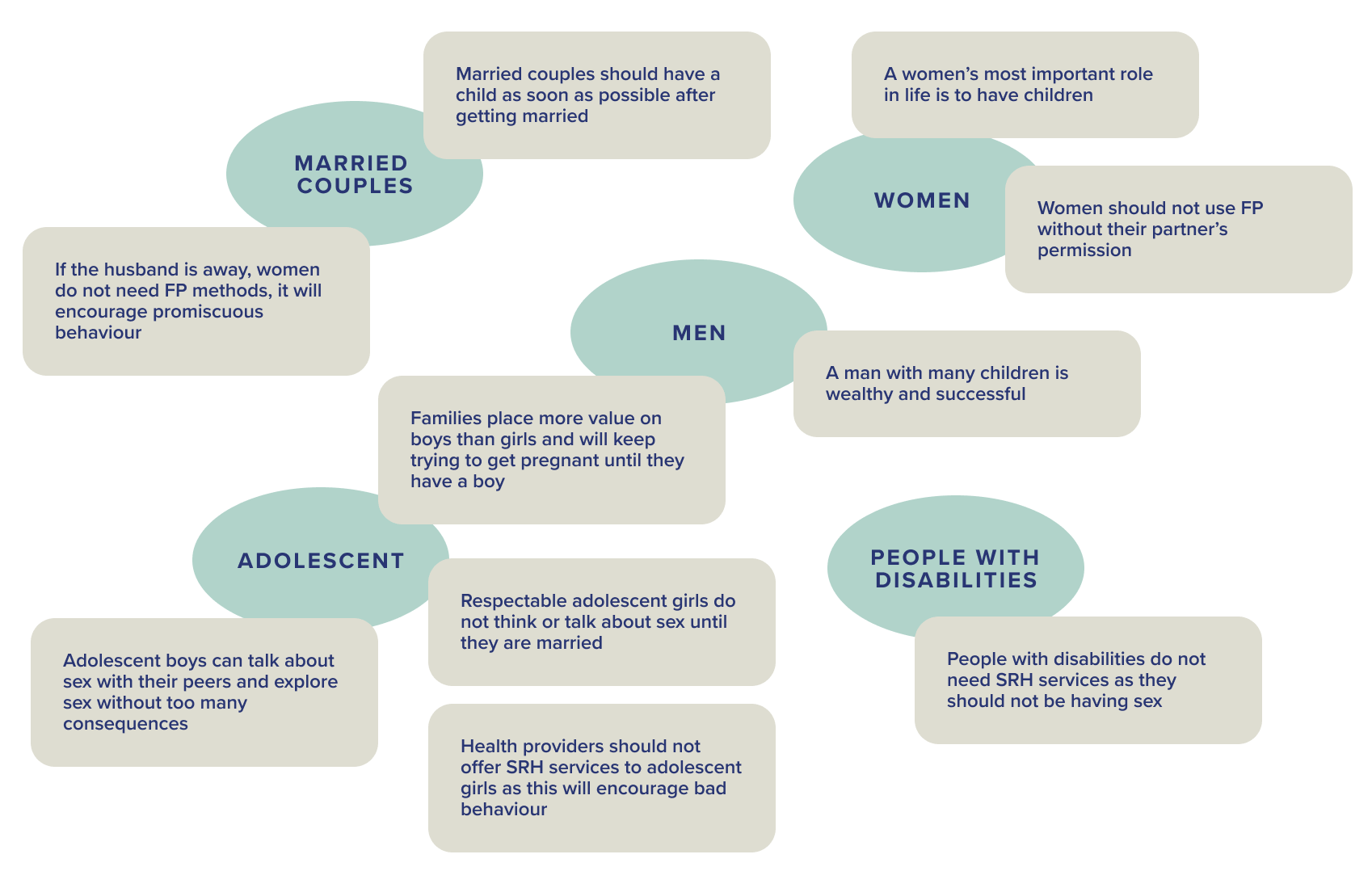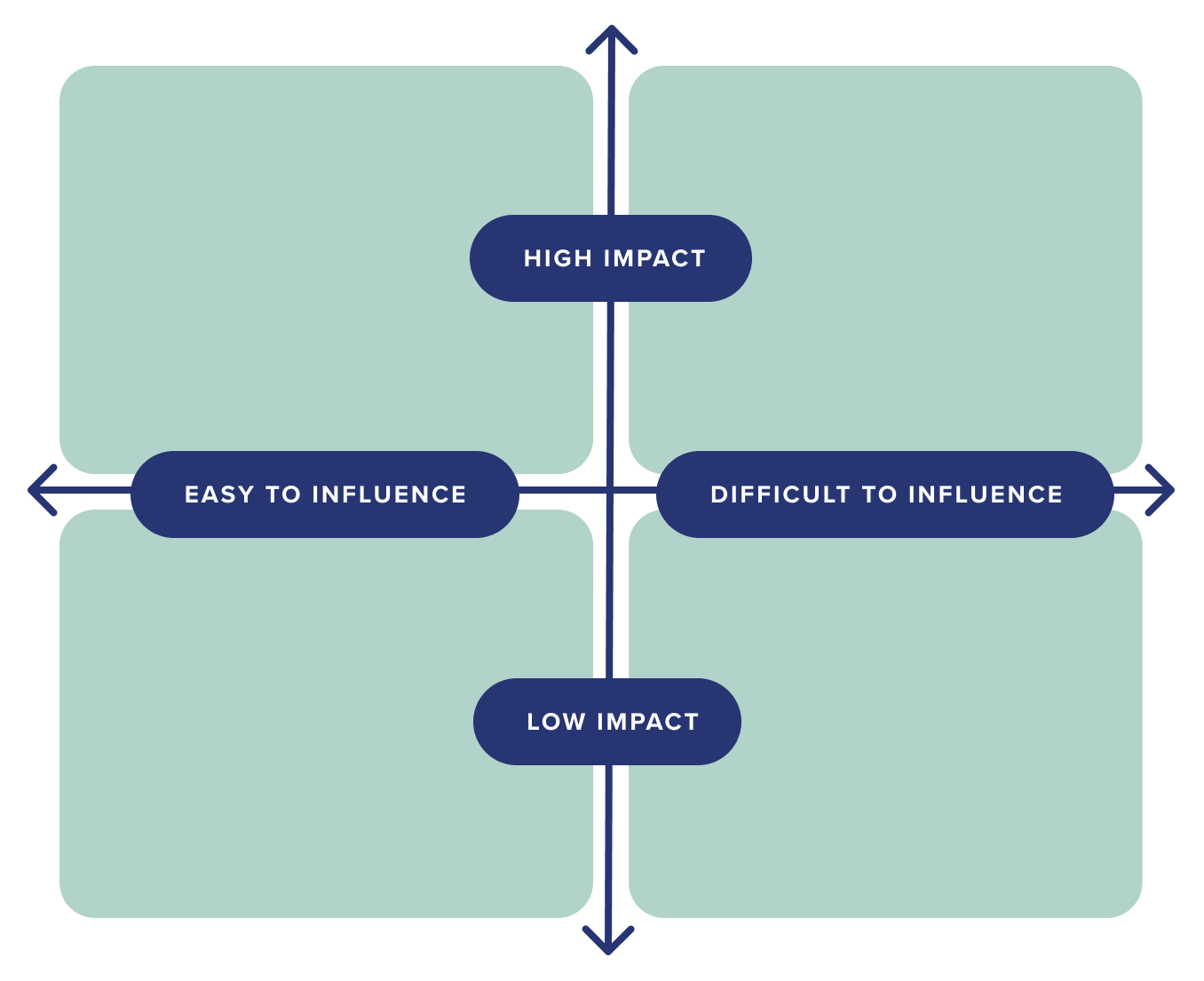Analysing social norms
Analysing social norms
Before we can think about designing impactful messaging or activities, we need to make sure we have a detailed understanding of the social norm we are faced with.
Say you have the following notes from your social norms brainstorm on different target audiences.

Now that you’ve got some social norms in front of you, let’s analyse them!
The SNAP Framework
Using the Social Norms Analysis Plot (SNAP) framework, we can understand how a social norm affects people’s behaviour in the community. The table essentially asks you to describe the norm you’re working with, in 4 different ways. It helps you understand the core issues: is this norm mainly about what you think others are doing, so you should do the same? Or is it more about expectations of what others approve of? Filling it in also helps us design activities and offers a framework to monitor initial reactions to the activities in question.
| Empirical expectations | Normative expectations | Sanctions and rewards | Reference groups | Exceptions |
|---|---|---|---|---|
| “What I think others do” | “What I think others expect me to do/approve of” | “What I think will happen if I do or don’t follow the norm” – and how much that matters to me | The people who shape/ influence the norm | Under what situations it is acceptable to break the norm. |
This looks complex, but becomes much easier when we break it down with an example.
Empirical expectations: “What I think others do”
- I believe most people in my community have a lot of children.
Normative expectations: “What I think others expect me to do/approve of”
- I believe most people in my community expect me to have a lot of children.
Sanctions and rewards: ““What I think will happen if I do or don’t follow the norm” – and how much that matters to me”
- If I do not have a lot of children, people in my community will consider me a failure as a woman.
- If I do have a lot of children, people will respect me.
Reference groups: the people who shape/influence the norm
- My husband and his family won’t think me worthy as his wife until I have lots of children.
- Other women in my community will think less of me.
- My mother-in-law will look down on me.
Exceptions: Under what situations it would be acceptable to break the norm.
- The norm may be so strong, that you cannot easily answer this question. This gives you an idea of how heavily the sanctions and rewards weigh on the target audience’s mind, and will help us inform programming later.
- In this example, the answer could be if the woman is unmarried.
Now try it yourself! Use the SNAP tool here. Fill in the template with your own example.
Tip! Five Whys
Tip
If you’re getting stuck, try the “Five Whys” – just ask “why” five times until you get to the core of the reasons!
Tip! Reference groups
Not sure about the reference groups? Try asking…
Which group do people feel they belong to? (community, tribe,…)
How are information, gossip, rumours spread?
Who are the role models?
Where do people go to for advice?
Who do people see most often?
Focus Case Study: MSI Nigeria Gagarabadau
Below is an example of how a SNAP framework was used in a real intervention at MSI. The Gagarabadau project works to engage men in addressing negative social norms and enabling FP access in northern Nigeria. The SNAP framework that was developed following a mapping and prioritisation exercise, was the following:
| Social Norm: | To be regarded as successful and be respected in their community men should have a large family | A woman’s worth is linked only to her ability to bear and bring up children; women who use contraception are trying to avoid having children |
|---|---|---|
| Empirical expectations (what I think others do) | Successful men in my community have lots of children | A good wife will provide her husband with lots of children |
| Normative expectations (what others expect me to do) | People in my community expect men to have a lot of children if they are to be respected | People in my community expect women to bear many children for their husband and for child-rearing to be their primary focus |
| Sanctions (how do others react if people do not conform to the norm) | Men who do not have large families are not respected and not considered successful | Women who do not have lots of children, or who focus on other activities beyond child-rearing, are not good wives |
| Reference groups | Peers, community leaders,… | Male and female peers, community leaders, family-in-law,… |
| Exceptions (when is it ok to break the norm?) | It is important to space births, for the sake of the health and economic security of my family | A woman has other things to contribute to her family besides child-rearing |
You can check the section on activity design to see how this was translated into an activity.
Understanding the power of a norm
Once you have identified the sanctions/rewards and exceptions involved with the social norm in question, you can now question how powerful a given norm is. This will help you decide on approaches for messaging on this norm: as we will see in the programming section, sometimes a norm is simply too powerful to remove, but can be leveraged, countered or changed in different ways.
The Power Calculator tool can help you identify these opportunities and get a sense of the power of the norm through 3 aspects: the strength of the norm’s control; sanctions; and acceptance.
How to use the tool: Review the questions. If the answer is “strong”, add 2 in the score column; 1 for “weak”; and 0 for “don’t know”. Try to avoid too many “don’t know” answers to get a more reliable result. Always review the total score in conjunction with the individual category scores, as this will help you identify opportunities!
How to read the results: Have a look at the filled-out example in the second tab of the tool. The norm “Married women should have as many children as possible soon after marriage” in rural Burkina Faso scored 17/20, making it a clearly powerful norm.
| 1 Control: How likely is it that people are willing to go against the norm? | Score |
|
Factor 1: Detectability Weak: the behaviour is private, not many people see it Strong: the behaviour is public, many people will see it |
2 |
|
Factor 2: Exceptions Weak: there are a lot of ways to explain/justify not following the norm Strong: it's difficult to explain/justify not following the norm |
1 |
|
Factor 3: Reference network Weak: There are no powerful people pushing to hold up this norm Strong: Powerful people actively defend this norm |
2 |
| Control score: | 5/6 |
| 2 Sanctions: How bad are the consequences of not following the norm? | Score |
|
Factor 1: Social pressure Weak: social expectations are low Strong: social expectations are strong |
2 |
|
Factor 2: Social role of the norm Weak: Powerful people would not be very upset if the norm changes Strong: Powerful people would be upset if the norm changes |
2 |
|
Factor 3: Number of norms involved Weak: The norm is not supported by a deeper norm Strong: The norm is supported by multiple norms |
2 |
| Sanction score: | 6/6 |
| 3 Acceptance: How widespread is the norm? | Score |
|
Factor 1: Deviation Weak: Not everyone adheres to the norm Strong: Almost everyone adheres to the norm |
2 |
|
Factor 2: Attitudes Weak: People follow the norm without thinking about it very much Strong: People defend the norm |
0 |
|
Factor 3: Agency Weak: Individual agency is high Strong: Individual agency is low |
2 |
|
Factor 4: Alternatives Weak: There are other norms or values held by multiple people who challenge the norm Strong: The norm aligns with the broader set of community norms and values |
2 |
| Acceptance score: | 6/8 |
| Total power score: 17/20 |
However, as you can see, there are opportunities:
- Control score 5/6: We found that it is fairly easy to come up with exceptions to the norm, for example by emphasising the benefits of birth spacing. This could be a great opportunity!
- Acceptance score 6/8: We did not know for sure if people follow the rule without thinking about it too much, or if they actively defend it. Insight gathering could help you see if there’s an opportunity there!
What now? Prioritising the social norms to work on
You have mapped and analysed the most impactful social norms in your context.
You can now use the simple template below to help narrow your focus. We also have a tool version of it here.
- Impact: how much influence the norm has on our desired behaviour
- Ease of influence: how easily our programming/activities could affect this – opportunities through existing interactions, reference group power,…
